In the world of automotive detailing, techniques and tools have seen significant advancements over the last dozen years. Rotary polishing is one such technique that was once a staple in the detailing industry. However, as the industry progresses and embraces new technologies, rotary buffing has gradually become a dated technique that's fading from the forefront. In this detailed blog, we'll explore the reasons behind the decline of rotary buffing and the modern alternatives that have taken its place.
Understanding Rotary Buffing:
Rotary buffing or polishing, involves the use of a rotary buffer equipped with a rotating pad to apply abrasives, compounds, or polishes to a vehicle's paint surface. The buffer rotates in a circular motion generating friction, which helps to remove imperfections, swirl marks, and scratches from the paint by creating a level and reflective surface.
Why Rotary Buffing Was Popular:
Rotary buffing was once a popular technique due to its ability to effectively correct paint imperfections and how quick it is able to do so. Detailers valued its power and versatility, especially for tackling deep scratches and severe paint defects. It was a go-to method for achieving high levels of paint correction in a shorter amount of time.
The Downside of Rotary Buffing:
While rotary buffing had its merits, it also came with significant downsides:
-
Risk of Damage: For the unexperienced, the high-speed rotation and aggressive nature of the technique can lead to paint burns (shown below), holograms, and uneven surfaces if not executed perfectly.
-
Heat Generation: The friction generated by rotary buffers can lead to excessive heat buildup, which risks burning the paint surface and causing irreversible damage.
-
Inconsistent Results: Achieving consistent and uniform results with rotary buffing can be challenging, especially for those without extensive experience. This inconsistency can lead to uneven paint correction and an unsatisfactory finish, especially for beginners!
-
Safety Concerns: Handling a powerful rotary buffer demands caution and proper technique. It can be physically demanding and tiring for detailers, increasing the risk of accidents or fatigue-related mistakes.
Modern Alternatives in Paint Correction:
As the detailing industry evolves, newer and more advanced techniques have emerged that offer safer and more precise results:
-
Dual Action (DA) Polishers: Dual action polishers are the now "King" polishers in the industry due to their orbital and oscillating motions, which reduces the risk of heat generation and paint damage. They're user-friendly and provide a more forgiving approach to paint correction. Dual action polishers have become the preferred choice in automotive detailing due to several advantages over rotary buffers. They are safer for paint surfaces, as their oscillating motion disperses heat and minimizes the risk of damage. Dual action polishers are user-friendly and forgiving, suitable for beginners and professionals alike.
-
Precision Polishing: Detailers now prioritize precision and controlled paint correction. Techniques like spot correction and wet sanding allow for targeted paint improvement while minimizing the risk of damage. Gone are the days of polishing entire vehicles all the time.
-
Advanced Polishing Compounds: Modern polishing compounds and abrasives are designed to work effectively with newer polishing tools. These products offer enhanced performance and safer results. The combinations of pads, compounds, and polishers can be endless and still get to near-perfect results.
While rotary buffing played a significant role in the history of automotive detailing, its limitations and risks have contributed to its decline in today's detailing landscape. Detailers now prioritize precision, safety, and consistent results, leading to the adoption of modern alternatives. As the industry continues to advance, it's crucial for detailers to stay updated on the latest techniques and tools that offer superior outcomes while minimizing the potential for paint damage.





